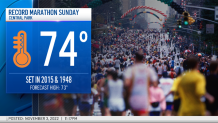Most of us may be enjoying the unseasonably warm weather expected to continue into next week, but there are about 50,000 people who aren't exactly looking forward to the spring-like temperatures.
That's because they're set to run 26.2 miles through all five boroughs on Sunday in the 2022 New York City Marathon — and record highs well into the 70s are not something they likely were expecting.
Temperatures for the race are expected to approach record highs. Twice, in 1948 and 2015, temperatures hit 74 degrees on Marathon Sunday. Highs for this Sunday are (as of now) forecast for 73 degrees — so the warmest NYC Marathon on record is not out of the question.

As a result of the unexpected warmth (and perhaps just as importantly, the elevated humidity), race organizers sent a letter to runners on Thursday giving recommendations on how to dress and what to do to ensure all participants stay safe and healthy.
To reach the finish line, race officials suggest wearing lighter layers and a hat, and finding shade where possible. And, naturally, staying hydrated. The race medical director advised drinking plenty of fluids before, and obviously during, the marathon.
Get Tri-state area news delivered to your inbox. Sign up for NBC New York's News Headlines newsletter.
Also a key piece of advice to runners: Don't start too fast, and be sure to slow down if you feel yourself heating up. For anyone who feels faint, dizzy, disoriented, or whose skin is clammy and abnormally hot or cold — slow down or stop running entirely.
News
Organizers said that medical stations are located every mile starting at mile 3, and that water will be available at 21 official fluid stations every mile from mile 3 to mile 25, except at miles 5, 7, and 9 (where there are medical stations with fluids and ice). There will also be Gatorade at fluid stations, bananas at miles 21 and 23, and energy gels at miles 12 and 18.
There will be misting stations added along the course in every borough except Staten Island (where the race begins) to help runners cool down, organizers said.
There will also be a color-coded flag system at the start of the race and next to medical stations that will communicate status of the course conditions. Here is what each flag will mean:
- Green flag – Excellent conditions – run as you wish
- Yellow flag – Less than ideal conditions – slow down a bit
- Red flag – Significant issues with conditions – slow down and be prepared to stop
- Black Flag – The race is stopped – stop running and listen for instructions



